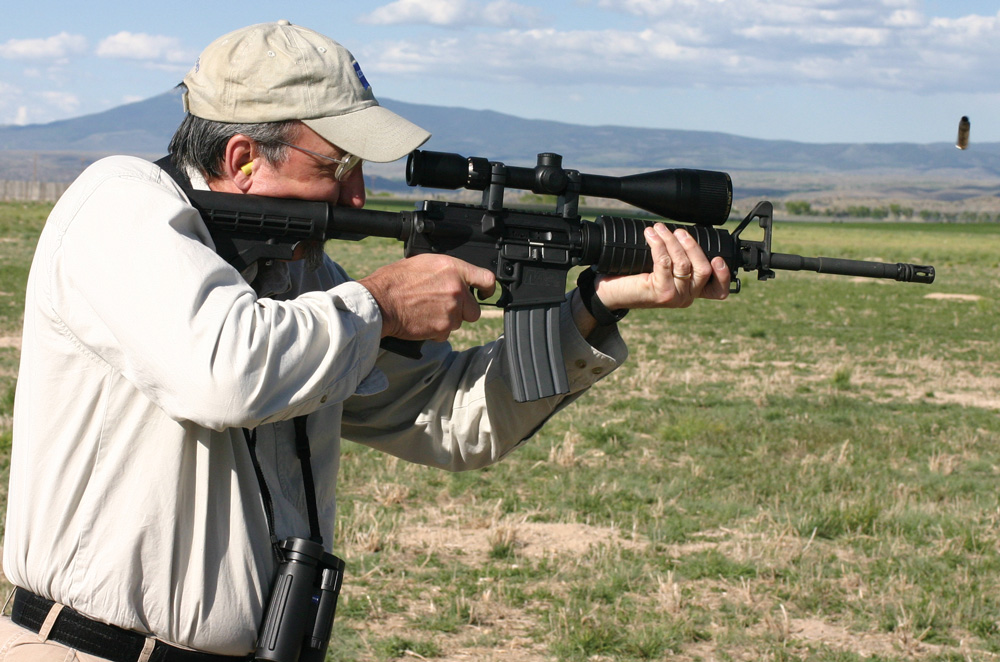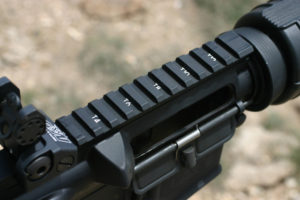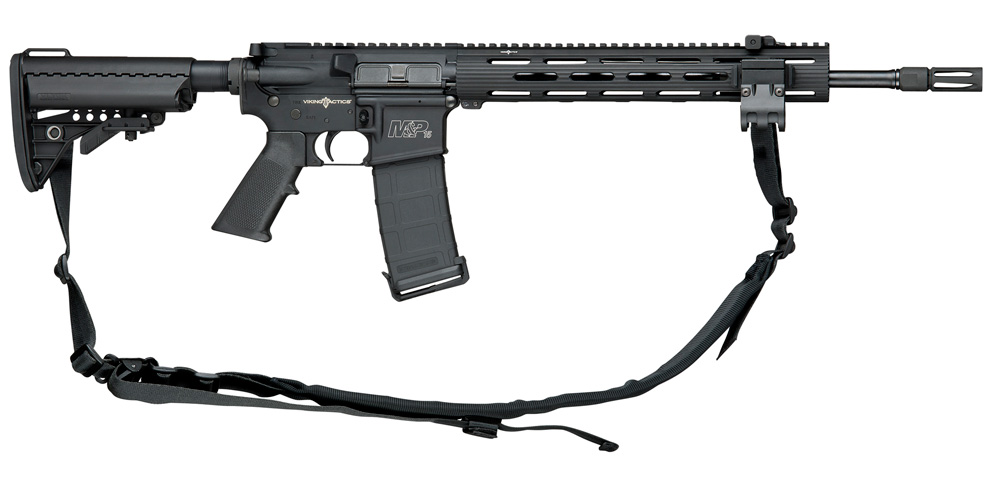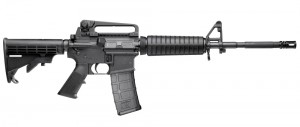
In this early Smith & Wesson M&P-15 review, Patrick Sweeney's verdict on the AR-style carbine is in: Get one.
The major components of the S&E M&P-15 come from Continental Machine & Tool. Known in the industry as “CMT,” they are a big behind-the-scenes maker of parts for many manufacturers. In fact, a lot of the rifles tested in this book (and Volume 1 as well) were assembled using CMT components. So in that regard S&W is not alone.
The three rifles offered are a standard M4, a tactical carbine with a railed forearm, and a precision rifle built up by the Performance Center. I had quite some time testing both the M4 and the Tactical. My first hands-on of the two was on a Wyoming prairie dog shoot.

I found myself along with several other gun writers at a ranch in the middle of Wyoming, to shoot prairie rats. We had a literal truckload of Winchester varmint ammo, and a selection of S&W M&P-15s to shoot. Being the sneaky, underhanded gunsmith that I am, I took a quick look at the rifles and found the one with the best trigger. That was serial number 221.
I then mounted the scope so far forward to accommodate my skinny frame and odd shooting stance that no one else could shoot it, thus guaranteeing I would have that one the whole trip.
For those who have not done so, prairie dog shooting is not hunting. Despite what some call it, it is plinking at animate targets. (Sssh, don’t let hunting haters know that.) You drive to a suitable spot, set up, and start shooting (“suitable” as in “lots of prairie dogs and other assorted vermin”). Vermin is what they are.
They’re members of the despised family rodentia, and we were warned repeatedly not to get too close to them, as they are all infected with various diseases and prone to carry ticks, fleas and God-knows-what. You shoot until you run out of targets, ammo or time. How big are the targets? Basically, one or two playing cards in size. How far can you shoot? As far as you can hit.

The rifles had off-brand scopes on them that limited my shooting time. They were clear enough to get my hits. I was shooting a hundred percent out to about two hundred yards, and only dropping to fifty percent out to three hundred. #221 really loves Winchester 40-grain varmint and 50-grain ballistic silvertip ammo.
My misses usually came from mis-doping the wind. I’m not usually shooting on targets that small out that far and rarely bother much with wind doping. But after a couple of hours I’d have to take a break, and then I used the Tactical model with iron sights on targets a hundred yards and in closer.
The rifles all had the 5.56 chamber and one turn in nine inches barrels, so reliability wasn’t a problem. The problem was the scope. It was just enough not-sharp that after shooting for a couple of hours I was starting to get a headache.

The irons of the Tactical model gave me a rest. I could also use the bolt gun with a Leupold scope on it, but I wasn’t the only one taking a break. I know I went through over five hundred rounds of Winchester ammo in both the morning and afternoon session.
The only maintenance I gave #221 was to lube the bolt and carrier after lunch. Once lunch was over we were back out again, slaying critters.
One of our shooting locations in the two days we were at it, gave us a slightly rising field out to almost four hundred yards. Out to three hundred the drop of the .223/5.56 was not that much, and easy to deal with. A bit of hold over and we could walk our shots in. As part of the experience, I had brought my 7X42 Conquest Zeiss binoculars along. Superb! Spectacular!
Taking turns using the binoculars as spotter, we could call the hits and misses for each other, and get on-target out in the field. The holdover at 400 yards was quite a bit. Depending on what ballistic coefficient you believe, and where you zero (a 200-yard zero would be good for this kind of work) the bullet will be dropping twenty inches or so out at 400 yards and drifting quite a bit, even in a light breeze.
We finished the first day and went back for dinner, talk and sleep. The next morning at breakfast there was the rumor that someone has stayed up late into the night cleaning rifles but if so Wyoming should hire better night-time gun-cleaning gnomes.
I oiled up #221 and went out to do more shooting. In the course of the two days of shooting I estimate that I shot something on the order of 2,500 rounds through #221. I oiled it now and then, and otherwise left it alone. It never failed me once.

I mentioned to S&W that perhaps it would be fun to have them send me this rifle for the book, so I could take a closer look at it once I got home. In due time a long package arrived, and #221 was here. The tactical model I shot is off somewhere else, probably doing the rounds to some police department or shooting demo somewhere. I didn’t get that serial number. In the interim someone had actually cleaned it. (I was shocked.)
The trigger was as nice as I’d remembered, and the only thing to do was get it out and check accuracy. So I took a Leupold scope and bolted it into the Armalite scope mount I had on hand. That, and some Wolf performance (the Winchester ammo hadn’t arrived by then) went out to the range with me.
The boresighter had done its job, as the groups were dead-on. No need to adjust unless I wanted to be fussy, and very small indeed. MOA groups with M-193 ball are not supposed to be the norm, but my observation is that we have seen the days of a 3 MOA AR-15 being acceptable. At least in the well-built ones. One MOA is the new standard.

Number 221 is your basic A2-lower M4 clone. The telestock is the non-CAR type, with six positions.
The lower is marked around the selector with “Safe” and “Fire” on both sides. Interestingly enough, on the trigger mechanism sideplates we see the rollmark of “Model M&P 15” which is the usual location of the original maker who machined the lower. I guess a marking variance can include the change of the markings there, too.
On the magazine well on the left side is the basic info, the S&W logo, and serial number, all looking pantograph engraved. The later, four-digit serial numbered rifles I saw had the serial number roll marked. Not a big deal, just noticeable once you’ve looked at a few thousand ARs.
On the right side the mag well is laser-etched with the M&P logo that S&W now uses. This one has “15” as part of the logo. On the handguns the logo includes the caliber.
The barrel is marked “5.56 NATO 1/9” which tells us the chamber and the rifling twist. It does not indicate as to chrome-lining or not, but in this day and age, with S&W using 4140 as the barrel steel, I’d be greatly surprised if it were not chrome-lined. When I used it in Wyoming it did not have a rear sight on it.
You can have yours with or with the standard detachable M4 carry handle/sight. If you do not want the carry handle, you can opt for the M&P-15A, which comes with a Troy BUIS. The front sight housing is the proper “F” marked height for use on a flat-top, so you can swap for any other BUIS you want, if you take off the M4 and install an optic.
The Tactical uses Troy handguards and front and rear sights. Nestled inside the front sight housing of the M&P-15 and the A model is a mil-spec side sling adapter, complete with NSN part number. Out on the end is a standard A2 flash hider. However, the barrel is threaded so you can swap it out and replace it with something else if you so wish.
Inside, the M&P-15 uses an AR hammer, a modified M-16 carrier, and a standard-weight buffer. As an added bonus, a close inspection revealed a telling detail: the buffer tube castle nut is staked. In talking with S&W before the unveiling of the M&P-15, I mentioned there were a number of details on which AR builders were slacking off.
Staking the castle nut was one of them. Staking of the carrier key is another, and I’d be happier if the S&W rifle had a more-robust staking there. The fit of the upper and lower is tight. You won’t have shift or rattle, but for a while you may have to tap the rear pint to get it to move for disassembly.
The S&W M&P-15? Get one.
Our Top Articles on AR-15 Builds and Performance
- AR-15 Buying Guide – Options For Any Budget
- Differences Between AR-10 and AR-15 – How Stoner’s Rifles Stack Up
- Best AR-15 Accessories & Parts
- AR-15 Lower Internals Setup
- How To Setup AR-15 Upper
- Buyer's Guide: Best Pistol Braces for ARs
- Affordable AR Pistol Options
- AR-15 Cartridge Options – What Should You Chamber Your Carbine?
This article is an excerpt from The Gun Digest Book of the AR-15 Vol. II.

Next Step: Get your FREE Printable Target Pack
Enhance your shooting precision with our 62 MOA Targets, perfect for rifles and handguns. Crafted in collaboration with Storm Tactical for accuracy and versatility.
Subscribe to the Gun Digest email newsletter and get your downloadable target pack sent straight to your inbox. Stay updated with the latest firearms info in the industry.

![Best Concealed Carry Guns In 2025 [Field Tested] Wilson Combat EDC X9S 1](https://gundigest.com/wp-content/uploads/Wilson-Combat-EDC-X9S-1-324x160.jpg)


![Best 9mm Carbine: Affordable PCCs [Tested] Ruger Carbine Shooting](https://gundigest.com/wp-content/uploads/Ruger-Carbine-Shooting-100x70.jpg)
![Best AR-15: Top Options Available Today [Field Tested] Harrington and Richardson PSA XM177E2 feature](https://gundigest.com/wp-content/uploads/Harrington-and-Richardson-PSA-XM177E2-feature-100x70.jpg)

Do all S&W AR-15 have the .223-5.56 barrel with the 5.56 chamber leede ? I would like to know for safety’s sake if it is ! Mine is # TK11679 (stamped .223 – 5.56 1/9) bought in 2020.
If it is questionable, I would get the M-Guns gage ($85.00).
What is a “standard weight buffer?” How many ounces? H, H2, etc?
I bought one that was on sale, had a 6x scope mounted & set for me! Also bought 1000 rounds of .223 ammo (my barrel is stamped 5.56 NATO) and was under $900! This is a really great addition to what I have! Plan on getting some 5.56 ammo and another mag! Would eagerly recommend this to anyone!